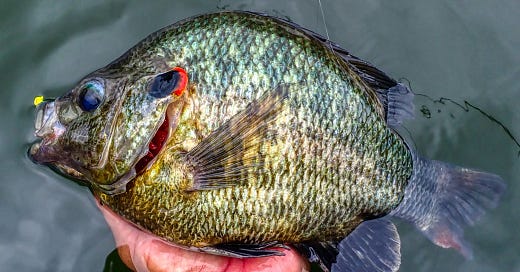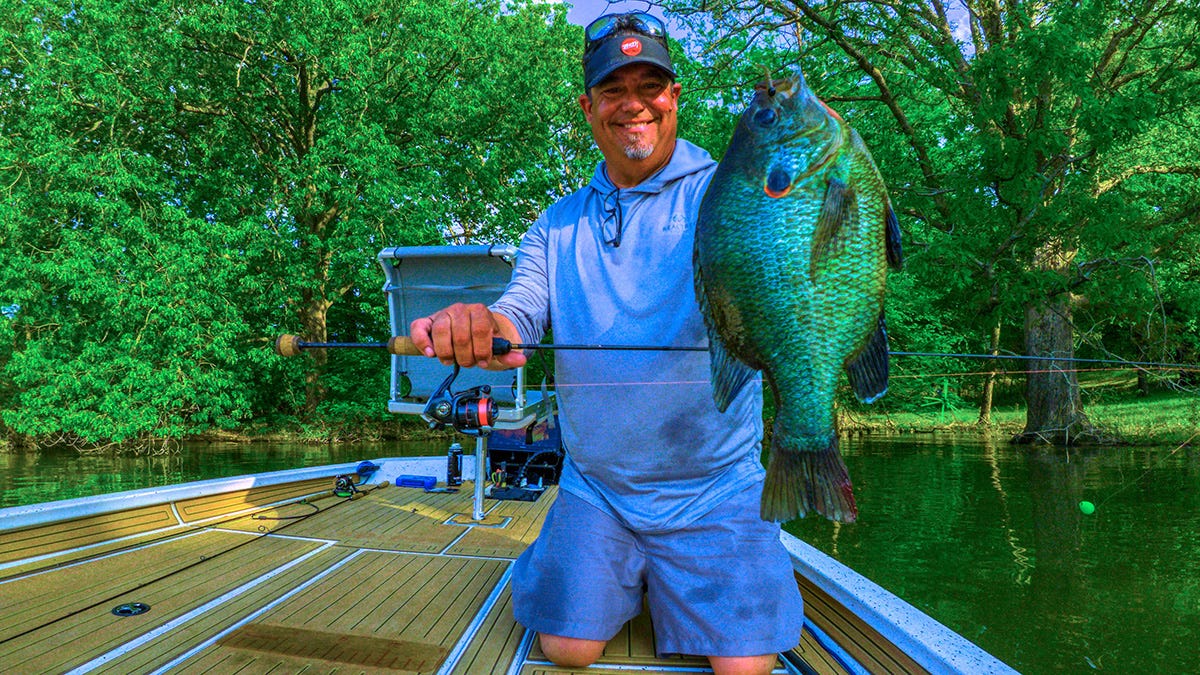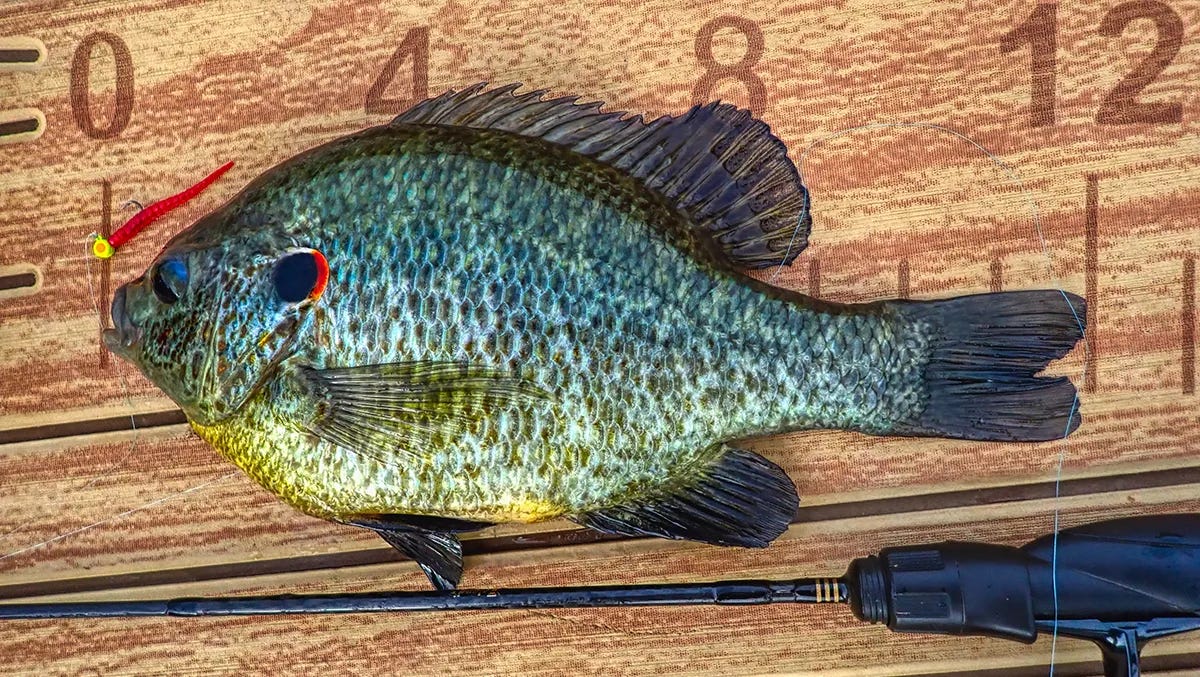Advanced Fishing Tips for the Mysterious Shellcracker
Successful patterns and observations on the behavior of red ear sunfish
I’ve been chasing red ear sunfish for a good long while now and have learned a ton over recent years about their preferences, migrations, diets, behaviors and more. While they are still arguably the most mysterious fish in the lake, they can be patterned, and I’m working with biologists, other anglers and spending a lot of hours exploring and experimenting to learn as much as we can about their habits and preferences to help anglers catch them more consistently.
I’ve been hot and heavy into chasing red ears during the spawn the last few weeks and thought I’d share some of my insights since so many people are bombarding my inbox with messages asking for help to catch red ears. And I love that. This fish seems to pique the interested of more than its fair share of anglers. A good many people are dying to catch a big red ear and unsure of how to begin.
I’ve shared a lot of insight over the years on various outlets like Wired2fish, Realtree and others, but I will provide a bit of background information that should help, dispel some myths and share some insights that will hopefully help you get on a lot more of these seemingly elusive fish.
RED EAR PRIMER
There is as much bad information as good floating around out there related to red ear sunfish. One of the myths I commonly hear at Kentucky Lake is that the red ear bed deeper than the bluegills. In my experience, the exact opposite is true more often than not. I find way more red ear beds shallower than the bluegill beds.
So take everything you hear from random people about red ear with a grain of salt. If you have not seen them post dozens of pictures of red ear, then maybe take what they say at face value. They may have accidentally stumbled onto one nest, one time and now claim gospel from that single good fortune.
And same goes for what I say. The biggest thing I learned with red ears is that they are very individualistic fish. Yes they may group up a bit to feed or spawn. But they are loners a lot of the year or move in very small groups of 2-4 fish. So they can do very different things.
I’ve seen beds in inches of water and also as deep as 10 feet. Ive seen them feed on the bottom and suspend over brush in 20 feet of water. They will go out super deep in the winter and super shallow in the spring and fall. They are as unpredictable as predictable.
I’ve also heard myths about them only being bottom feeders. This assertion is completely false. Yes they do love snails and those are generally on the bottom. They also like midges, chironomids, mayfly larvae and a host of other micro invertebrates, worms, shrimp and more. They definitely eat mussels and snails on the bottom. But that is not all. They are often in open water suspended. So don’t be overly one dimensional in your searches for them.
One other thing I tell people is finding red ear is inherently difficult on many fisheries because they are so few compared to other species in a lake. On Kentucky and Barkley Lakes, you will catch 1,000 bluegills for every one red ear you catch. That’s how low density they are on our lakes, and we have better than average red ear fishing than most places. People get really discouraged I’ve found about not catching shellcrackers. Really you just have to fish a lot before you find them consistently. Because it takes eliminating a lot of water to catch them because they are so few and far between.
WHERE I LOOK FOR RED EARS
I hope the following tips will help you confine your searches to the most likely areas. These observations are based on dozens of encounters and more importantly ruling out acres and miles of water on large riverine reservoirs. Kentucky Lake is a massive fishery. And 90% of the fish are in 10% of the water. Meaning 90% of Kentucky Lake will not hold any fish most of the time. I think with red ear, it’s probably closer to 99%.
But I’ve been putting common denominators together with other good red ear anglers, biologists and more to be able to pattern them a lot better in recent years. And I’ve learned a lot along the way.
During the spawn, you are looking for shallow water flats, with hard bottoms, and something they can make a bed “next to.” I often start my search around the last contour depth change in a pocket or bay. Where it goes from shallow to too shallow. If they make their beds to shallow, they feel exposed. So they often make their beds next to something like a laydown, a rock vein, a hard piece of something like a rock or stump or even just the contour created by a large bluegill bed.
It’s very common to find a bluegill bed, and on the edges of those beds, find 3 or 4 beds that look different. Those almost always end up being red ear beds.
I have found a lot of beds with a good pair of polarized sunglasses. I actually worked with Island Optics to help them develop a low light lens just to help me find red ear beds in shaded pockets and shaded banks.
I have also changed my search for them where instead of looking for beds I look for movement. Whether with my sunglasses or my electronics. I’m not just looking for what looks like a bed, but also fish moving. I have had some red ear beds fool me because I couldn’t see the beds because of a broke up bottom, or things like weeds that made seeing the beds difficult on my electronics or with my eyes.
UNDERSTAND HOW THEY FEED
A lot of novice anglers don’t realize that those little slight nibbles they feel are often red ear. They definitely will grab a bait and move off with it, but more often than not they will come up and just nibble and crunch on something without swallowing it all in one shot. I learned this in a red ear tournament years ago. I was getting little nibbles and if I would just wait until the line began to move off before setting the hook, I ended up catching a big red ear every time.
I think they crunch and sample things at times before committing. So if you get those nibbles, definitely keep casting and working in the area.
I also learned that they are not really big on chasing lures. They want a lure to move, even erratically at times, but they don’t want to have to run something down. Most of what they eat is just there to eat. It doesn’t swim off. I have caught a ton of big red ear on a jig under a float. When they are bedding, I want the jig to sit just inches off the bottom. But I want to be able to move the bait without taking it away from them.
I employ a lift and drop retrieve often because of this. I’m not talking about hopping it up 2 feet and letting it hit again. Those retrieves take your jig out of their zone too fast. I literally will just reel a half turn to lift my jig and then stop abruptly to let it fall. I will also fish a light lure so I can swim it ultra slow with a shaking retrieve. I do this a ton with Panfish Magnets on a 1/64 ounce Eye Hole Jigs.
IMPROVE YOUR ODDS TO CATCH RED EAR
One of my big non-negotiables with red ear involves scent. I think scent matters more in bluegill and red ear fishing than it does in bass or crappie fishing. They are extremely scent oriented. So I always have some sort of scent on my lures. With the Eye Hole jigs, I can put a Slab Bite in the eye socket and have scent and a good looking offering. If I don’t have that option I will rub my lure in some sort of scent to increase my odds. And I reapply often when the bite slows.
I use light line, but I also often use light braid. I want to feel what my jig is doing and any slight nibble or change in pressure on my line. Red ear sunfish are sneaky eaters. They are able to pick it up and just sit without you knowing you even got a bite. So you need a more direct connection at times. I will always use a fluoro leader. They can be line shy and I always looking for ways to tip the scale in my favor.
I have caught red ears on yellow line, direct to braid and with monofilament. But often the best setup for me has been 5-8 pound braid with a 4-pound fluoro leader. I keep my hook size to No.6 or No. 8. I use long narrow forceps to get hooks out, but those smaller hooks account for way more hook ups for me.
I wrote a piece on the 7 Best Panfish Lures to Catch Big Gills and Red Ear. My go-tos lately have been the Panfish Magnet in Natural on a 1/64 ounce black Eye Hole Jig and my hand tied nymphs. I tie a variation of a Wooly Worm or a Gill Getter with a large 5.5 Tungsten Bead to fool big red ears.
I fight the fish slowly as a 2-plus-pound red ear can hurt your feelings on 2-4 pound line. I usually have a net handy. I can tell I have a red ear when I set the hook if they do a straight run that pulls drag. A gill will immediately get on his side or circle but a big red ear almost always goes on a straight run right out of the gate. When I feel that, I slow and down and play the fish and use a net.
I have become a proponent of 8-foot rods. These long rods like the iRod XPan or the FishUSA Flagship Ultralight Spinning are dynamite for throwing light jigs on light line and playing down big red ears. I didn’t think I would like such long rods for panfish, but they have proven to be far superior for me in my fishing with light jigs and light line.
I hardly ever scan for beds any more when it comes to red ear fishing. I spend way more time on the deck of my boat fishing into shallow water. Casting, looking, probing around cover and those last depth changes in a pocket or the back of a bay or creek. I think I find so many beds because I don’t look just for a big bed out deep with electronics. I look physically and fish my way into productive areas.
I will argue a red ear is more skittish than a crappie. So if you scan through a real shallow area, you have likely already messed it up. It’s also why when you find a bed that has a lot of red ear, you can only get 6-8 of them to bite before the bed shuts down. They actually spook each other when hooked. You do that a few times in a row and now the whole bed is “on guard” and tough to get to bite now.
I don’t look as much for giant beds as much as I look for good red ear areas that check a lot of boxes. I don’t want mud or clay banks. I want hard packed gravel rock bottoms. I want to see shells and snails present. I want to see some sort of edge or cover to make them feel safe. And then I want to keep my bait in their area as long as possible with some scent for added attraction.
I was allowed to participate in a biology project recently tracking red ear with telemetry trackers. The project is being run by a grad student Justin Graben out of Murray State who is a former KDFW biologist. He and I have known each other for a long time, and it’s been really fun comparing notes with each other and seeing how they are tracking red ears to help us all understand their behaviors, preferences and tendencies through the year.
I am working with Dr. Flinn out of Hancock Biological Station and Murray State to sample bluegills, red ear and crappie to understand their feeding changes as they migrate from area to area in various seasons. All of us will compare notes and share info so we can provide anglers with a blueprint of diet profiles, migration and transition patterns from season to season on the various panfish species we all love.
I have a ton more coming on the subjects of red ear, bluegill and panfish in general, and will be highlighting some of the working going on behind the scenes studying panfish behavior from your local biologists as well as sharing lots more of my insights as I chase panfish all over the place, so be sure you are subscribed so you get the latest updates in your inbox.









Great article. Can you tell me what color lenses you use from Island Optic?
I caught a 2 lb 9 pounce red in November in Kentucky lake!!